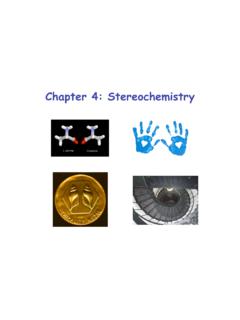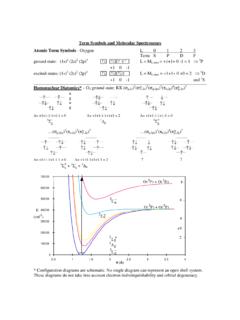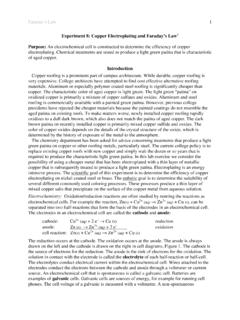Transcription of Faraday’s Law 1 Experiment 8: Copper Electroplating and ...
1 Faraday s Law 1 experiment 8 : Copper Electroplating and Faraday s Law1 Purpose: An electrochemical cell is constructed to determine the efficiency of Copper Electroplating . Chemical treatments are tested to produce a light green patina that is characteristic of aged Copper . Introduction Copper roofing is a prominent part of campus architecture. While durable, Copper roofing is very expensive. College architects have attempted to find cost effective alternative roofing materials. Aluminum or especially polymer coated steel roofing is significantly cheaper than Copper . The characteristic color of aged Copper is light green. The light green patina on oxidized Copper is primarily a mixture of Copper sulfates and oxides.
2 Aluminum and steel roofing is commercially available with a painted green patina. However, previous college presidents have rejected the cheaper materials because the painted coatings do not resemble the aged patina on existing roofs. To make matters worse, newly installed Copper roofing rapidly oxidizes to a dull dark brown, which also does not match the patina of aged Copper . The dark brown patina on recently installed Copper is primarily mixed Copper sulfide and oxides. The color of Copper oxides depends on the details of the crystal structure of the oxide, which is determined by the history of exposure of the metal to the atmosphere. The chemistry department has been asked for advice concerning treatments that produce a light green patina on Copper or other roofing metals, particularly steel.
3 The current college policy is to replace existing Copper roofs with new Copper and simply wait the dozen or so years that is required to produce the characteristic light green patina. In this lab exercise we consider the possibility of using a cheaper metal that has been electroplated with a thin layer of metallic Copper that is subsequently treated to produce a light green patina. Electroplating is an energy intensive process. The scientific goal of this Experiment is to determine the efficiency of Copper Electroplating on nickel coated steel or brass. The esthetic goal is to determine the suitability of several different commonly used coloring processes. These processes produce a thin layer of mixed Copper salts that precipitate on the surface of the Copper metal from aqueous solution.
4 Electrochemistry: Oxidation/reduction reactions are often studied by running the reactions as electrochemical cells. For example the reaction, Zn(s) + Cu2+ (aq) Zn2+ (aq) + Cu (s), can be separated into two half-reactions that form the basis of the electrodes in an electrochemical cell. The electrodes in an electrochemical cell are called the cathode and anode: cathode: Cu2+ (aq) + 2 e Cu (s) reduction anode: Zn (s) Zn2+ (aq) + 2 e oxidation cell reaction: Zn(s) + Cu2+ (aq) Zn2+ (aq) + Cu (s) The reduction occurs at the cathode. The oxidation occurs at the anode. The anode is always drawn on the left and the cathode is drawn on the right in cell diagrams, Figure 1. The cathode is the source of electrons for the reduction.
5 The anode is the sink of electrons for the oxidation. The solution in contact with the electrode is called the electrolyte of each half-reaction or half-cell. The electrolytes conduct electrical current within the electrochemical cell. Wires attached to the electrodes conduct the electrons between the cathode and anode through a voltmeter or current source. An electrochemical cell that is spontaneous is called a galvanic cell. Batteries are examples of galvanic cells. Galvanic cells are sources of energy, for example for running cell phones. The cell voltage of a galvanic is measured with a voltmeter. A non-spontaneous Faraday s Law 2 electrochemical cell is called an electrolytic cell. Electrolytic cells require an external source of energy, Figure 1 b.
6 The electrochemical cell in this Experiment is electrolytic and as such requires an external current source to run the reaction. anode: cathode: anode: cathode: left right left right oxidation reduction oxidation reduction e sink e source e sink e source cathode: Cu2+ (aq) + 2 e Cu (s) cathode: Ni2+ (aq) + 2 e Ni (s) anode: Zn (s) Zn2+ (aq) + 2 e anode: Cu (s) Cu2+ (aq) + 2 e a. Galvanic cell b. Electrolytic cell Figure 1: (a). Galvanic cells, such as batteries, produce energy. Reduction always occurs at the cathode, drawn on the right. (b). Electrolytic cells require an external source of energy. The reduction of Ni at the cathode is not spontaneous so that an external energy source is required.
7 The anode and cathode electrolytes are often different in electrochemical cells. The electrolytes then are brought into contact either directly through a porous separator or indirectly using a salt bridge, which is a solution of a non-redox active strong electrolyte such as KNO3. In this Experiment both electrodes are Cu electrodes with the object to be electroplated attached as the cathode. The cathode and anode have a common electrolyte in this Experiment . Cu2+ ions are oxidized into solution from the anode into the electrolyte and then reduced from the electrolyte onto the cathode, Figure 2. The current source attached to an electrolytic cell is the source of electrons. As a result, in electrochemical cells, electrons can be thought of as a reactant or product of the chemical reaction, just like any other reactant or product.
8 The current flowing through the cell is directly related to the chemical changes occurring in the overall cell reaction. A current source can be thought of as a reagent bottle of electrons! Theory The unit of electric current is the ampere, which is equivalent to the charge carried in coulombs per second: 1 amp = 1 C s-1. The charge of a single electron is e, where e is the fundamental unit of electric charge: 1 e = C. For chemical purposes, the charge carried by a mole of electrons is more commonly encountered. The charge carried by a mole of electrons is 1 F, with the Faraday defined as the charge of a mole of fundamental charges: 1 F = e NA = C ( mol-1) = 96485 C mol-1 1 Zn2+ SO42- anode + cathode Zn Cu Cu2+ SO42- V + voltmeter Cu2+ SO42- anode + cathode Cu Ni Ni2+ SO42- + current source Faraday s Law 3 The Faraday establishes the equivalence of electric charge and chemical change in oxidation/reduction reactions.
9 For example consider the reduction of nickel at the cathode of an electrochemical cell, Figure 1b: Ni2+ + 2 e Ni (s) 2 As written, the reduction of one mole of Ni2+ ions requires 2 moles of electrons, with corresponding charge Q = 2 F. If the current flowing through the electrochemical cell is constant, the charge carried through the cell is: Q = I t (constant current) 3 where I is the current in amperes and t is the time the current is applied in seconds. A current of one amp flowing for one second transfers one coulomb of charge: 1 amp s = 1 C s-1 s = 1 C. If the current varies with time, the total charge carried is the integral of the current from time equals zero to time t : Q = t0 I dt (varying current) 4 Let the number of electrons transferred in the balanced electrochemical reaction be z.
10 For the nickel example, z = 2. Then the number of moles of product, n, is given by dividing the total charge carried by zF: n = QzF 5 This expression is called Faraday s Law of Electrolysis. Example: Faraday s Law A current of amp for 672 s is used to electroplate nickel at the cathode of an electrochemical cell containing NiSO4 (aq). Calculate the mass of nickel metal produced. Answer: The cathode reaction is given by Eq. 2, so that the number of electrons in the half-cell reaction is z = 2. The total charge carried is given by Eq. 3: Q = I t = amp (672 s) = C s-1(672 s) = 343 C The number of moles of nickel that plate out on the cathode are given by Eq. 5: n = QzF = 343 C2(96485 C mol-1) = mol The mass of nickel is given using the atomic molar mass of nickel: mass Ni = mol ( g mol-1) = g The electrochemical cell in this exercise is Cu | Cu2+ | Cu, Figure 2.
















